This article covers the following areas –
- Why Should You Have a Vertical Garden in Your Living Room?
- What Are the Types of Vertical Garden Systems?
- How to Prepare Your Living Room for Vertical Gardening?
- How to Choose the Right Plants for Your Living Room Vertical Garden?
- How to Install Your Living Room Vertical Garden?
- Guide to Maintaining Your Living Room Vertical Garden
- 5 Tips for Seasonal Updates of Your Living Room Vertical Garden
- In Conclusion
Vertical gardening is a fantastic way to add greenery to your living space without using up precious floor space. It’s perfect for those who live in small apartments or simply want to incorporate more plants into their home. In this article, I’ll share how to create a stunning and functional vertical garden in your living room using simple techniques and readily available materials.
Choose the right plants based on your living room’s light conditions, and select a suitable vertical garden system like wall-mounted planters, modular systems, pocket gardens, or ladder shelves. Ensure proper installation, maintenance, and customization to create a living room vertical garden.
Now, let’s know about the ins and out of an ideal living room vertical garden. I’ll share from my experiences the important things to consider while creating a vertical garden for your living room.
Why Should You Have a Vertical Garden in Your Living Room?
Incorporating a vertical garden in your living room offers numerous benefits, from saving space and enhancing aesthetics to improving air quality and promoting well-being. By investing time and effort into creating a lush, green oasis, you’ll enjoy a more pleasant and healthy living space.
While I was developing a vertical garden in my living room, I considered a few reasons. Here are 6 reasons why you should consider a vertical garden for your living room.
#1 Space-saving Solution
Vertical gardens are perfect for those with limited space, as they make use of vertical surfaces like walls instead of occupying precious floor space. This allows you to have more plants without cluttering your living room, giving you the freedom to design your space without sacrificing your love for greenery.
#2 Enhances the Room’s Aesthetics
A living wall can transform your living room into a vibrant and inviting space. With a variety of plant colors, textures, and shapes, you can create a stunning visual masterpiece that adds depth and character to your room. Vertical gardens can also be customized to match your interior design style, making them versatile and unique design elements.
#3 Improves Indoor Air Quality
Plants are natural air purifiers that help filter out harmful toxins and pollutants present in the air. By creating a vertical garden in your living room, you’re not only adding visual appeal but also actively improving the air quality. This can have a positive impact on your health, especially for those with allergies or respiratory issues.
#4 Reduces Stress and Promotes Well-being
Studies have shown that being in the presence of plants can reduce stress and anxiety and even improve concentration. By creating a vertical garden in your living room, you’re cultivating a calming and soothing atmosphere that can help you relax and unwind after a long day. The presence of plants can also boost your overall mood, contributing to a more positive and pleasant living environment.
#5 Encourages Creativity and Personal Expression
Designing and maintaining a vertical garden allows you to express your creativity and personal style. You can experiment with different plant combinations, themes, and arrangements, making your living room a reflection of your unique personality.
#6 Provides a Sense of Accomplishment
Taking care of a vertical garden can be a rewarding experience as you watch your plants thrive and grow. This sense of accomplishment can have a positive impact on your mental well-being, making vertical gardening a fulfilling and enjoyable hobby.
What Are the Types of Vertical Garden Systems?
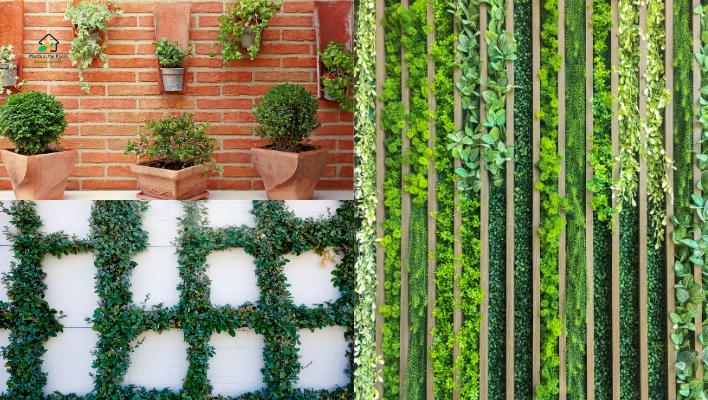
Creating a vertical garden in your living room requires choosing the right system that suits your needs, preferences, and available space. With numerous options in the market, it’s essential to understand the features and benefits of each type of vertical garden system.
There are several vertical garden systems available to suit your needs and preferences. In this section, we’ll explore four popular vertical garden systems.
Wall-Mounted Planters
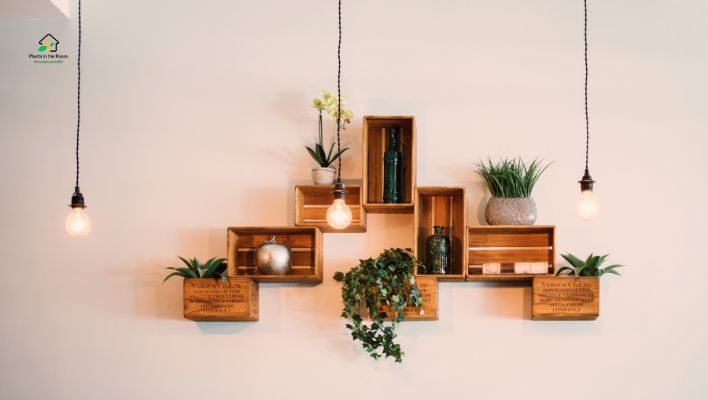
Wall-mounted planters offer flexibility and customization for your vertical garden. They can be attached to your wall in various patterns, such as a grid, staggered, or even a more organic arrangement.
These planters are available in a wide range of materials, including metal, wood, and ceramic, allowing you to choose a style that complements your living room decor. Installation typically requires the use of brackets, anchors, or adhesive strips, depending on the weight of the planters.
Modular Vertical Garden Systems
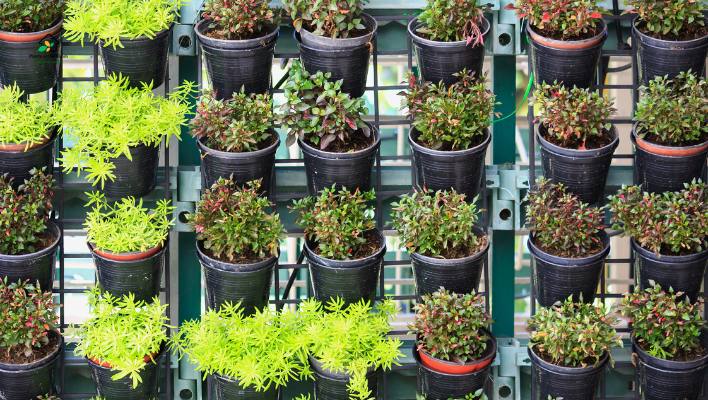
Modular systems are versatile and user-friendly options for creating a living wall. These systems often consist of interlocking panels or containers that can be arranged and customized to fit your specific space and design preferences.
Some modular systems come with built-in irrigation, making plant maintenance more manageable. Modular vertical gardens can be easily expanded or rearranged as your plant collection grows, giving you the freedom to experiment with various layouts and plant combinations.
Pocket Gardens

Pocket gardens are made of fabric or felt materials and feature pockets or slots for inserting plants. This vertical garden system is lightweight and easy to install, typically requiring only a few hooks or nails to hang. The fabric material allows for proper air circulation and drainage, promoting healthier plant growth.
Pocket gardens are ideal for those who want a low-maintenance and cost-effective solution for their living room vertical garden. However, it’s essential to choose plants with smaller root systems, as the pockets may not provide enough space for larger root growth.
Ladder Shelves for Vertical Plant Displays

Ladder shelves are a simple and affordable option for creating a vertical garden in your living room. These freestanding shelves can be placed against a wall, allowing you to display potted plants at varying heights.
Ladder shelves come in various styles, materials, and sizes, making it easy to find one that fits your living room’s aesthetic. This type of vertical garden system is perfect for those who want a non-permanent solution or prefer to keep their plants in individual pots for easier maintenance and rearrangement.
How to Prepare Your Living Room for Vertical Gardening?

Before installing your vertical garden, it’s essential to prepare your living room to ensure a successful and visually appealing setup. Follow these steps to create the perfect environment for your new green addition:
Step 1: Assess the Available Light
Evaluate the amount of natural light your living room receives throughout the day. Take note of the light patterns and identify areas with direct, indirect, or low light. Understanding your living room’s light conditions is crucial for selecting plants that will thrive in your vertical garden and determining their ideal placement.
Step 2: Measure Your Space
Before choosing a vertical garden system, measure the height and width of the area where you plan to install it. Accurate measurements will help you select the right size garden system and determine the number of plants you’ll need for a visually balanced display.
Keep in mind any limitations, such as windows, doors, or electrical outlets, when selecting the location for your vertical garden.
Step 3: Choose a Focal Point
Decide where you want your vertical garden to be the center of attention in your living room. This will help you determine the best location for installation. Consider factors like visibility from different angles, proximity to seating areas, and the overall flow of your living room when choosing your vertical garden’s focal point.
Step 4: Protect Your Walls and Floors
If using a wall-mounted system or a system that requires drainage, it’s essential to protect your walls and floors from potential water damage. Install a waterproof backing or barrier behind your vertical garden to prevent moisture from seeping into your walls.
Additionally, consider placing a tray or waterproof mat beneath your vertical garden to catch any excess water and protect your floors.
Step 5: Plan for Irrigation and Drainage
Proper irrigation and drainage are crucial for maintaining a healthy vertical garden. Depending on the garden system you choose, you may need to set up an irrigation system or plan for manual watering.
Consider factors like water access and drainage when selecting the location for your vertical garden. Ensure there’s adequate drainage to prevent root rot and maintain your plants’ health.
How to Choose the Right Plants for Your Living Room Vertical Garden?
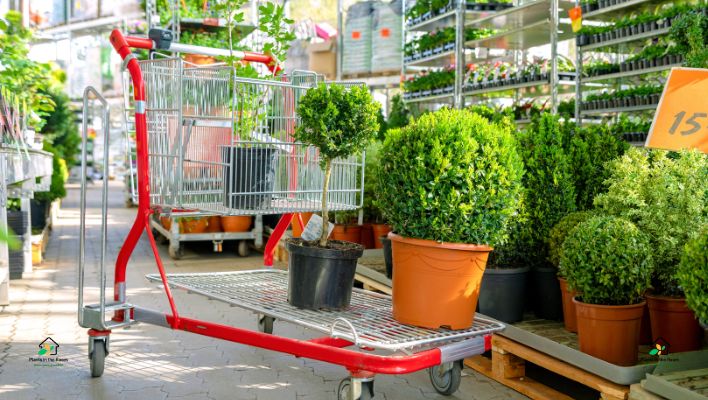
Choosing the right plants for your living room vertical garden is crucial to ensure their health and longevity while enhancing your space. Here are some key factors to consider when selecting plants for your vertical garden:
#1 Light Requirements
Evaluate the amount of natural light your living room receives throughout the day. Observe the light patterns and identify areas with bright, indirect, or low light. Choose plants that thrive in the light conditions available in your living room. Some popular choices include:
- Bright light: Fiddle leaf fig, snake plant, or spider plant
- Indirect light: Pothos, philodendron, or peace lily
- Low light: ZZ plant, cast iron plant, or Chinese evergreen
#2 Size and Growth Patterns
Consider the size and growth habits of the plants to ensure they’re suitable for your vertical garden system. Opt for plants with compact growth habits and avoid those with extensive root systems or aggressive growth patterns. Mixing plants with varying heights, textures, and foliage colors can create an eye-catching and dynamic display.
#3 Maintenance Requirements
Choose plants with similar care needs to simplify maintenance. If you’re a busy person or a beginner, opt for low-maintenance plants like snake plants, pothos, or succulents that can tolerate a bit of neglect. Make sure to group plants with similar watering and humidity requirements together in your vertical garden to ensure their well-being.
#4 Adaptability and Hardiness
Some plants adapt better to indoor environments and can tolerate fluctuations in temperature, humidity, and light conditions. Hardy plants like snake plants, ZZ plants, or ivy are excellent choices for a living room vertical garden, as they are more resilient and can withstand occasional changes in their environment.
How to Install Your Living Room Vertical Garden?
After selecting the ideal plants and vertical garden system for your living room, it’s time to set up and install your green oasis. Here’s a step-by-step guide on how to install your living room vertical garden:
Step 1: Follow the Manufacturer’s Instructions
Begin by following the manufacturer’s instructions for your chosen vertical garden system. This may involve attaching brackets, shelves, or panels to the wall using suitable hardware. Ensure that your vertical garden system is securely installed and level to prevent any issues with water drainage or plant stability.
Step 2: Prepare the Planting Containers or Pockets
If you’re using a pocket garden or modular system, start by filling each pocket or container with a high-quality potting mix specifically designed for indoor plants. This will provide your plants with the essential nutrients they need to grow and thrive.
Step 3: Plant Your Chosen Plants
Carefully plant your chosen plants in their designated spaces within the vertical garden system. Make sure to cover their roots well with soil to provide adequate support and promote healthy root development. Pay attention to the spacing between plants to ensure that they have enough room to grow without overcrowding.
Step 4: Attach Your Plants to the Vertical Garden System
Depending on your chosen system, you may need to attach your plants to the vertical garden structure. This could involve inserting them into pockets, securing them within containers or pots, or attaching them directly to a panel or trellis. Ensure that each plant is securely positioned within the system to prevent them from falling or becoming damaged.
Step 5: Water Your Plants Thoroughly
After planting, water your plants thoroughly to help them establish in their new environment. Use a watering can or bottle with a narrow spout to direct water to the plant roots without over-saturating the surrounding areas. Proper hydration will encourage strong root development and help your plants acclimate to their new vertical garden.
Step 6: Provide Support for Climbing Plants
If you’ve chosen climbing plants like philodendrons or ivy for your vertical garden, it’s essential to provide them with support structures to help them attach and grow vertically. This can include trellises, wires, or mesh panels. Secure these support structures to your vertical garden system and gently guide the climbing plants towards them as they grow.
With careful planning, proper installation, and attention to detail, your living room vertical garden will soon become a thriving, lush focal point in your home. Remember to monitor your plants closely during the initial weeks to ensure they adjust well to their new environment and provide any necessary care to promote healthy growth.
Guide to Maintaining Your Living Room Vertical Garden
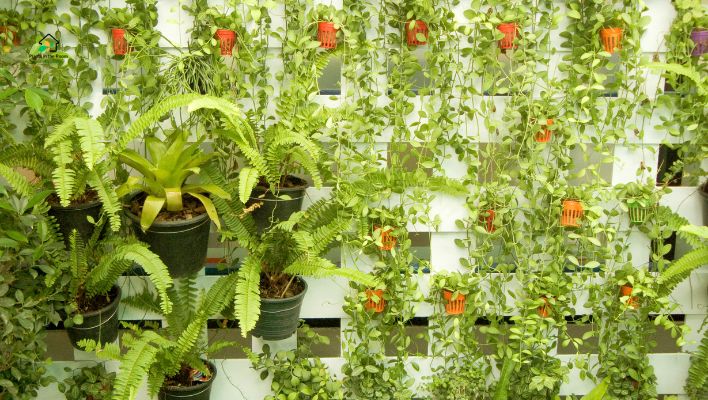
To ensure the continued health and beauty of your living room vertical garden, proper maintenance is essential. Follow these tips to keep your living wall looking its best and thriving:
#1 Regular Watering
Vertical gardens may require more frequent watering than traditional potted plants, as they tend to dry out faster. Regularly check the moisture level of your plants’ soil by inserting your finger about an inch into the soil. If it feels dry, it’s time to water. Be mindful not to over-water, as this can lead to root rot and other issues.
Adjust your watering schedule based on the specific needs of your plants and the environmental conditions in your living room.
#2 Fertilizing Your Plants
Feed your plants with an appropriate fertilizer every few months to ensure they receive the necessary nutrients for healthy growth. Follow the fertilizer instructions carefully and avoid over-fertilizing, which can harm your plants. Consider using a slow-release fertilizer or an organic option specifically designed for indoor plants.
#3 Pruning and Grooming
Regularly prune your plants to maintain their shape, encourage bushy growth, and remove any unhealthy or dead foliage. Remove dead or yellowing leaves and trim back overgrown areas as needed. Grooming your plants not only enhances their appearance but also promotes healthy growth and reduces the risk of pests and diseases.
#4 Pest and Disease Control
Keep a close eye on your vertical garden for any signs of pests or diseases. Common indoor plant pests include spider mites, aphids, and mealybugs, while diseases can manifest as leaf spots, mold, or root rot. Treat any issues promptly to prevent them from spreading to other plants in your vertical garden.
Use non-toxic pest control methods like insecticidal soap, neem oil, or diatomaceous earth to protect your plants and maintain a healthy living environment.
#5 Rotating Your Plants
To ensure even growth and exposure to light, consider rotating your plants every few weeks. Regular rotation helps to maintain a balanced appearance and can also help to prevent pests and diseases by promoting better air circulation around your plants.
#6 Monitor and Adjust
Regularly assess the overall health and appearance of your living room vertical garden. If you notice any issues or changes in your plants’ condition, take prompt action to address the problem. This may involve adjusting your watering or fertilizing schedule, treating pests or diseases, or relocating plants to better suit their light requirements.
By following these maintenance tips and regularly monitoring your living room vertical garden, you’ll be able to enjoy a lush, vibrant, and healthy green oasis in your home.
5 Tips for Seasonal Updates of Your Living Room Vertical Garden
Keeping your living room vertical garden refreshed and in tune with the seasons can bring a sense of renewal and vibrancy to your space. Here are some tips to help you make seasonal updates to your vertical garden:
Tip 1: Swap Out Plants for Seasonal Varieties
One of the easiest ways to give your vertical garden a seasonal update is by swapping out some plants for varieties that reflect the current season. For example, you can incorporate flowering plants that bloom during specific seasons, like spring bulbs, summer annuals, or autumn foliage plants. Changing a few plants seasonally can create a fresh look and keep your garden visually interesting.
Tip 2: Incorporate Seasonal Colors and Textures
Adjust your vertical garden’s color palette and textures to reflect the season. For instance, you can add plants with warm-colored foliage or flowers during autumn, or those with cool-toned leaves and blooms during winter. This can help create a more cohesive and harmonious look that complements your living room’s seasonal decor.
Tip 3: Add Seasonal Decorations
Incorporate seasonal decorations into your vertical garden to enhance its festive appeal. This can include adding small ornaments, fairy lights, or garlands during the holiday season, or incorporating decorative elements like miniature pumpkins or pinecones during autumn. Be creative and have fun with your decorations, but be sure not to overwhelm your plants or obstruct their access to light.
Tip 4: Adjust Your Plant Care Routine
As the seasons change, so do the needs of your plants. Monitor your plants closely and adjust your watering, fertilizing, and pruning routines to accommodate their seasonal requirements. Some plants may need more water during warmer months, while others may require less during cooler seasons. Adjusting your plant care routine can help ensure your vertical garden remains healthy and vibrant all year long.
Tip 5: Rotate Plants for Optimal Light Exposure
As the angle of the sun changes throughout the year, the light exposure in your living room may also shift. Keep an eye on the light levels in your living room and rotate or rearrange your plants as needed to ensure they receive adequate light for their specific needs. This can help maintain even growth and prevent your plants from becoming leggy or unhealthy.
By following these tips, you can keep your living room vertical garden looking fresh and seasonally appropriate. Seasonal updates not only enhance the visual appeal of your space but can also reinvigorate your plants, contributing to a healthier and more vibrant living environment.
In Conclusion
Creating a vertical garden in your living room is an excellent way to bring nature indoors and enjoy the numerous benefits of indoor plants. With the right plant selection, a suitable vertical garden system, and proper maintenance, you’ll have a stunning and functional living wall that enhances your living space.
Let your creativity run wild and enjoy the process of designing, planting, and nurturing your unique living room vertical garden oasis.






